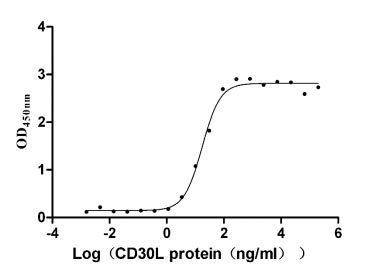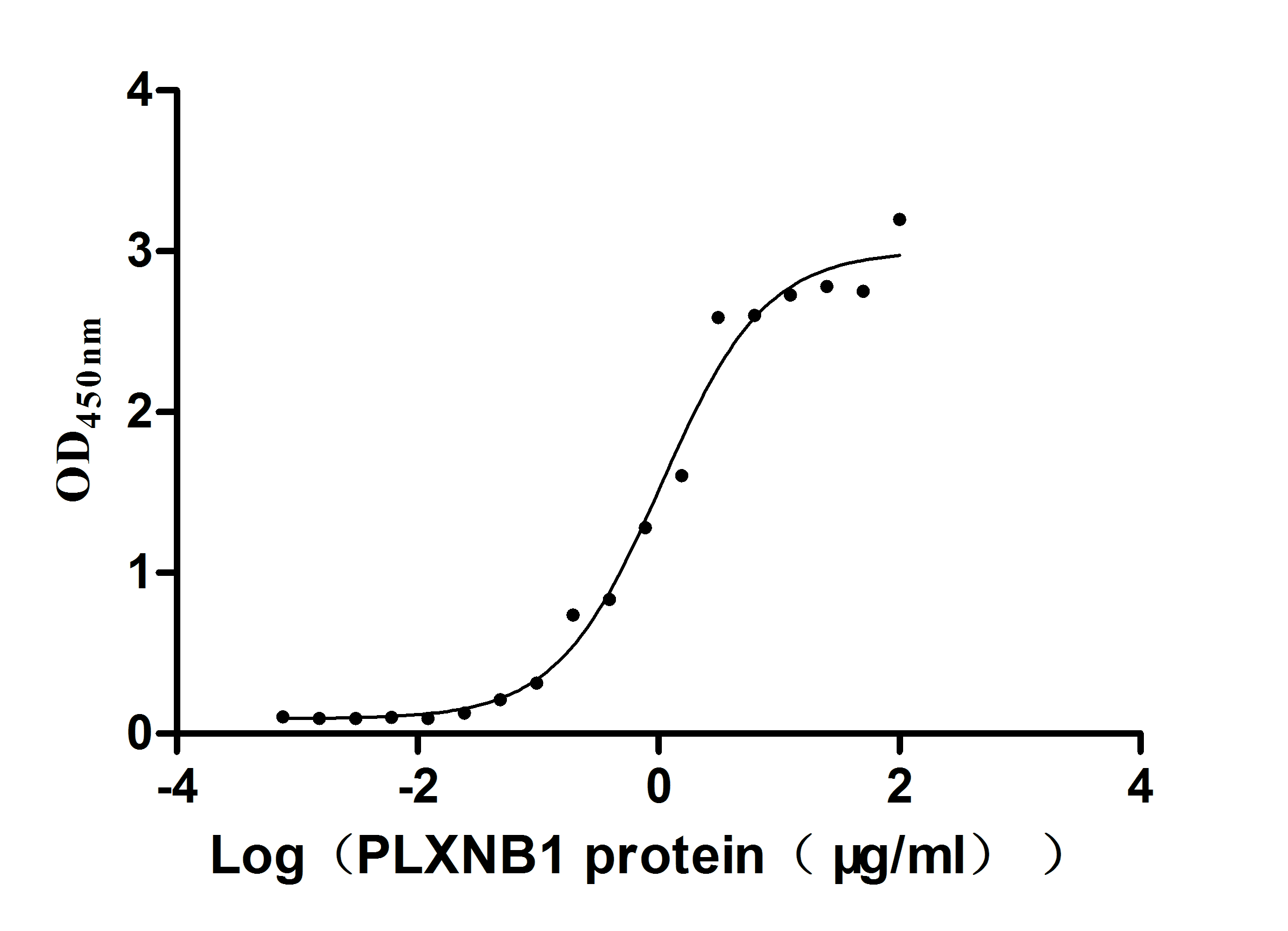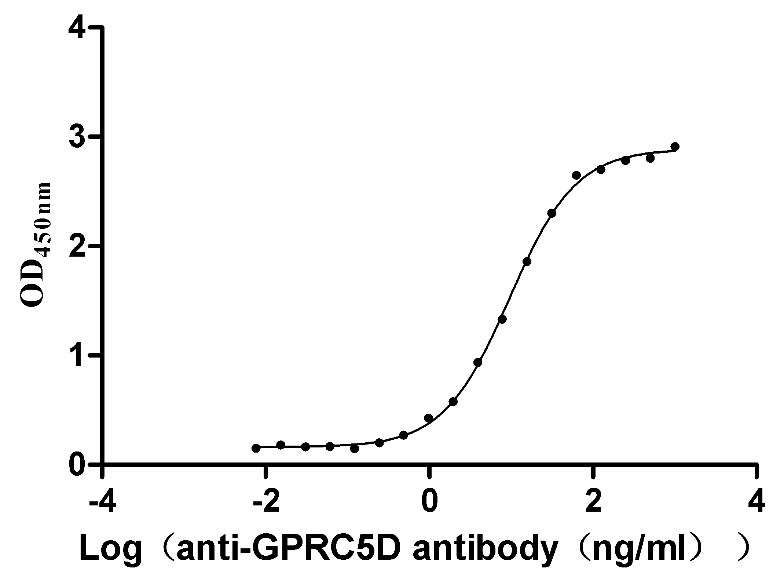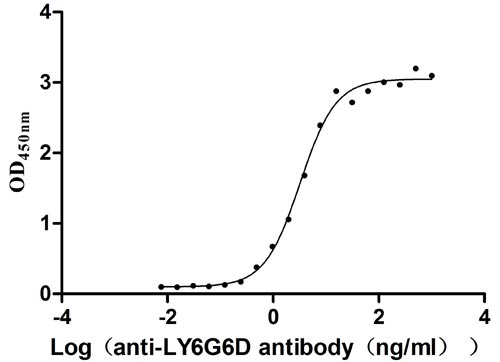Recombinant Human Peroxisomal targeting signal 1 receptor (PEX5)
-
中文名称:人PEX5重组蛋白
-
货号:CSB-YP017805HU
-
规格:
-
来源:Yeast
-
其他:
-
中文名称:人PEX5重组蛋白
-
货号:CSB-EP017805HU
-
规格:
-
来源:E.coli
-
其他:
-
中文名称:人PEX5重组蛋白
-
货号:CSB-EP017805HU-B
-
规格:
-
来源:E.coli
-
共轭:Avi-tag Biotinylated
E. coli biotin ligase (BirA) is highly specific in covalently attaching biotin to the 15 amino acid AviTag peptide. This recombinant protein was biotinylated in vivo by AviTag-BirA technology, which method is BriA catalyzes amide linkage between the biotin and the specific lysine of the AviTag.
-
其他:
-
中文名称:人PEX5重组蛋白
-
货号:CSB-BP017805HU
-
规格:
-
来源:Baculovirus
-
其他:
-
中文名称:人PEX5重组蛋白
-
货号:CSB-MP017805HU
-
规格:
-
来源:Mammalian cell
-
其他:
产品详情
-
纯度:>85% (SDS-PAGE)
-
基因名:PEX5
-
Uniprot No.:
-
别名:FLJ50634; FLJ50721; FLJ51948; PBD2A; PBD2B; Peroxin 5; Peroxin-5; Peroxisomal biogenesis factor 5; Peroxisomal C terminal targeting signal import receptor; Peroxisomal C-terminal targeting signal import receptor; Peroxisomal targeting signal 1 (SKL type) receptor; Peroxisomal targeting signal 1 receptor; Peroxisomal targeting signal import receptor; Peroxisomal targeting signal receptor 1; Peroxisome receptor 1; pex5; PEX5_HUMAN; PTS1 BP; PTS1 receptor; PTS1-BP; PTS1R; PXR1
-
种属:Homo sapiens (Human)
-
蛋白长度:Full length protein
-
表达区域:1-639
-
氨基酸序列MAMRELVEAE CGGANPLMKL AGHFTQDKAL RQEGLRPGPW PPGAPASEAA SKPLGVASED ELVAEFLQDQ NAPLVSRAPQ TFKMDDLLAE MQQIEQSNFR QAPQRAPGVA DLALSENWAQ EFLAAGDAVD VTQDYNETDW SQEFISEVTD PLSVSPARWA EEYLEQSEEK LWLGEPEGTA TDRWYDEYHP EEDLQHTASD FVAKVDDPKL ANSEFLKFVR QIGEGQVSLE SGAGSGRAQA EQWAAEFIQQ QGTSDAWVDQ FTRPVNTSAL DMEFERAKSA IESDVDFWDK LQAELEEMAK RDAEAHPWLS DYDDLTSATY DKGYQFEEEN PLRDHPQPFE EGLRRLQEGD LPNAVLLFEA AVQQDPKHME AWQYLGTTQA ENEQELLAIS ALRRCLELKP DNQTALMALA VSFTNESLQR QACETLRDWL RYTPAYAHLV TPAEEGAGGA GLGPSKRILG SLLSDSLFLE VKELFLAAVR LDPTSIDPDV QCGLGVLFNL SGEYDKAVDC FTAALSVRPN DYLLWNKLGA TLANGNQSEE AVAAYRRALE LQPGYIRSRY NLGISCINLG AHREAVEHFL EALNMQRKSR GPRGEGGAMS ENIWSTLRLA LSMLGQSDAY GAADARDLST LLTMFGLPQ
-
蛋白标签:Tag type will be determined during the manufacturing process.
The tag type will be determined during production process. If you have specified tag type, please tell us and we will develop the specified tag preferentially. -
产品提供形式:Lyophilized powder
Note: We will preferentially ship the format that we have in stock, however, if you have any special requirement for the format, please remark your requirement when placing the order, we will prepare according to your demand. -
复溶:We recommend that this vial be briefly centrifuged prior to opening to bring the contents to the bottom. Please reconstitute protein in deionized sterile water to a concentration of 0.1-1.0 mg/mL.We recommend to add 5-50% of glycerol (final concentration) and aliquot for long-term storage at -20℃/-80℃. Our default final concentration of glycerol is 50%. Customers could use it as reference.
-
储存条件:Store at -20°C/-80°C upon receipt, aliquoting is necessary for mutiple use. Avoid repeated freeze-thaw cycles.
-
保质期:The shelf life is related to many factors, storage state, buffer ingredients, storage temperature and the stability of the protein itself.
Generally, the shelf life of liquid form is 6 months at -20°C/-80°C. The shelf life of lyophilized form is 12 months at -20°C/-80°C. -
货期:Delivery time may differ from different purchasing way or location, please kindly consult your local distributors for specific delivery time.Note: All of our proteins are default shipped with normal blue ice packs, if you request to ship with dry ice, please communicate with us in advance and extra fees will be charged.
-
注意事项:Repeated freezing and thawing is not recommended. Store working aliquots at 4°C for up to one week.
-
Datasheet :Please contact us to get it.
相关产品
靶点详情
-
功能:Binds to the C-terminal PTS1-type tripeptide peroxisomal targeting signal (SKL-type) and plays an essential role in peroxisomal protein import.
-
基因功能参考文献:
- these findings lend credit to the idea that inefficient catalase import, when coupled with the role of PEX5 as a redox-regulated import receptor, constitutes a cellular defense mechanism to combat oxidative insults of extra-peroxisomal origin. PMID: 28760655
- TRIM37-mediated ubiquitylation stabilizes PEX5 and promotes peroxisomal matrix protein import, suggesting that mulibrey nanism is a new peroxisomal biogenesis disorder. PMID: 28724525
- Data suggest that soluble/cytosolic PEX5 interacts with PEX14/PEX13 complex, a model for the docking/translocation module (DTM) of the peroxisomal matrix protein translocon; PEX14/PEX13 complex appears to function in peroxisomal membrane as large cavity into which cytosolic PEX5 can enter to release its cargo. (PEX = peroxisomal biogenesis factor) PMID: 28765278
- data reveal subpopulations of peroxisomes showing only weak colocalization between PEX14 and PEX5 or PEX11 but at the same time a clear compartmentalized organization. This compartmentalization, which was less evident in cases of strong colocalization, indicates dynamic protein reorganization linked to changes occurring in the peroxisomes. PMID: 27311714
- our data suggest that insertion of the trimeric PEX5-PEX7-PTS2 protein complex into the DTM is probably accompanied by conformational alterations in PEX5 to allow release of the PTS2 protein into the organelle matrix PMID: 26138649
- Our data suggest that the functional polymorphism rs3814058C>T in 3'-UTR of PXR may be a functional biomarker to predict risk of colorectal cancer PMID: 26547791
- PEX5 encodes two isoforms, PEX5L & PEX5S, & a homozygous frame shift mutation c.722dupA (p.Val242Glyfs( *)33), located in the PEX5L-specific exon 9, results in loss of PEX5L only. Loss of PEX5L results in deficient import of PTS2-tagged proteins PMID: 26220973
- bulky side chain within the recognition motif, which blocks contraction of the PEX5 binding cavity PMID: 25369882
- Data show that ataxia-telangiectasia mutated (ATM) phosphorylates peroxisomal biogenesis factor 5 (PEX5) at serine 141 in response to reactive oxygen species. PMID: 26344566
- the molecular recognition of PTS1 cargo proteins by Pex5p PMID: 25689234
- ubiquitination of peroxisome-targeting signal type 1 (PTS1) receptor Pex5p regulating PTS1 protein import PMID: 24662292
- PEX5 has a role in regulating peroxisome numbers by signaling to mediate pexophagy PMID: 24453954
- Cys11 in PEX5 serves as a functional redox switch regulating the peroxisomal/cytosolic localization of peroxisomal proteins. PMID: 24118911
- The novel Pex14-binding site may represent the initial tethering site of Pex5 from which the cargo-loaded receptor is further processed in a sequential manner. PMID: 24235149
- Translocation of proteins across the organelle membrane occurs downstream of a reversible docking step and upstream of the first cytosolic ATP-dependent step, i.e. before ubiquitination of PEX5. PMID: 23963456
- The molecular mechanism of recognition by the peroxisomal receptor Pex5p, in complex with alanine-glyoxylate aminotransferase revealed by X-ray crystallography. PMID: 22529745
- Our results suggest that ubiquitin-specific protease 9X (USP9X) is by far the most active deubiquitinase acting on Ub-PEX5, both in female rat liver and HeLa cells. PMID: 22371489
- interaction of PEX5 with catalase and PEX14 PMID: 21976670
- The Peroxisomal targeting signal 1 in Scp2 is autonomous and is essential for binding to pex5. PMID: 21375735
- the affinities of the PTS1-containing peptides from 42 proteins from the human proteome for Pex5p PMID: 20178365
- Data suggest that translocation of PTS1-containing proteins across the peroxisomal membrane occurs concomitantly with formation of the Pex5p-Pex14p membrane complex and that this is probably the site from which Pex5p leaves the peroxisomal compartment. PMID: 12411433
- binds the PTS1 independently of Hsp70 and the peroxin PEX12 PMID: 12456682
- Binding energy threshold data have been generated for PTS1 pentapeptides containing different C-terminal tripeptide sequences to determine the functionality of specific PTS1 sequences. PMID: 12578380
- concluded that the PTS1 domain of SR-BI is functional and can mediate peroxisomal interaction via Pex5p, in vitro PMID: 14652019
- the N terminus of Pex5p is required for redirecting the peroxisome-associated peroxin back to the cytosol PMID: 15328363
- Pex5p is a monomeric protein with an abnormal shape PMID: 15866874
- Pex5 most likely enters peroxisomes, changes its interacting partners, and then exits using ATP energy. PMID: 16314507
- Results indicate that the N-terminal half of Pex5p is best described as a natively unfolded pre-molten globule-like domain. PMID: 16403517
- study shows mutation-dependent, gain-of-function association between myocilin & PTS1R; there was correlation between glaucoma phenotype & specific MYOC mutations, with more severe early-onset POAG mutations having higher degree of association with PTS1R PMID: 17317787
- Results describe the affinities of mutated forms of Pex5p for a series of peroxisomal targeting signal type-1 (PTS1) peptides and conclude that PTS1-affinity reductions are correlated with Zellweger disease severity and cell biological phenotype. PMID: 17399738
- A previously unobserved conformation for PEX5 suggests roles for intrinsic flexibility and rigid domain motions in ligand binding. PMID: 17428317
- E2D1/2/3 (UbcH5a/b/c) are the mammalian functional counterparts of yeast/plant Pex4p PMID: 18359941
- The location of the different mutations within the PEX5 amino acid sequence correlates rather well with the peroxisomal protein import defect observed in the cell lines. PMID: 18712838
- Results describe the properties of the soluble and membrane-bound monoubiquitinated Pex5p species (Ub-Pex5p). PMID: 19208625
- analysis of the human Pex5.Pex14.PTS1 protein complex structure obtained by small angle X-ray scattering PMID: 19584060
- the step of protein translocation across the peroxisomal membrane into the PEX5 cycling pathway PMID: 19632994
显示更多
收起更多
-
相关疾病:Peroxisome biogenesis disorder 2A (PBD2A); Peroxisome biogenesis disorder 2B (PBD2B); Rhizomelic chondrodysplasia punctata 5 (RCDP5)
-
亚细胞定位:Cytoplasm. Peroxisome membrane; Peripheral membrane protein. Note=Its distribution appears to be dynamic. It is probably a cycling receptor found mainly in the cytoplasm and as well associated to the peroxisomal membrane through a docking factor (PEX13).
-
蛋白家族:Peroxisomal targeting signal receptor family
-
组织特异性:Detected in heart, brain, placenta, lung, liver, skeletal muscle, kidney and pancreas.
-
数据库链接:
HGNC: 9719
OMIM: 202370
KEGG: hsa:5830
STRING: 9606.ENSP00000407401
UniGene: Hs.567327
Most popular with customers
-
Recombinant Human Tumor necrosis factor receptor superfamily member 8 (TNFRSF8), partial (Active)
Express system: Mammalian cell
Species: Homo sapiens (Human)
-
Recombinant Human Plexin-B1 (PLXNB1), partial (Active)
Express system: Mammalian cell
Species: Homo sapiens (Human)
-
Recombinant Human E3 ubiquitin-protein ligase ZNRF3 (ZNRF3), partial (Active)
Express system: Mammalian cell
Species: Homo sapiens (Human)
-
Recombinant Human G-protein coupled receptor family C group 5 member D (GPRC5D)-VLPs (Active)
Express system: Mammalian cell
Species: Homo sapiens (Human)
-
Recombinant Human Lymphocyte antigen 6 complex locus protein G6d (LY6G6D) (Active)
Express system: Yeast
Species: Homo sapiens (Human)
-
Recombinant Human C-C chemokine receptor type 8 (CCR8)-VLPs (Active)
Express system: Mammalian cell
Species: Homo sapiens (Human)
-
Recombinant Human Tumor-associated calcium signal transducer 2 (TACSTD2), partial (Active)
Express system: Mammalian cell
Species: Homo sapiens (Human)
-
Recombinant Human Tumor-associated calcium signal transducer 2 (TACSTD2), partial (Active)
Express system: Mammalian cell
Species: Homo sapiens (Human)




















